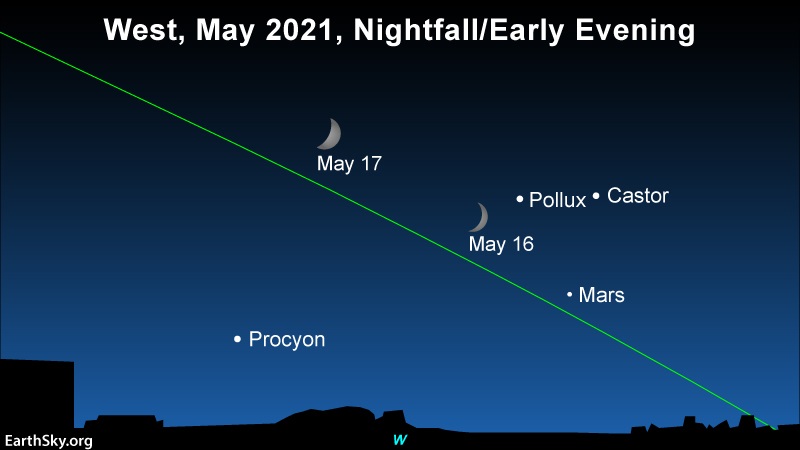Want to nab Mercury, the innermost planet of the solar system, sometimes called the most elusive planet? Now’s the time to catch this world, as Mercury, an inferior planet, swings to its greatest elongation east of the setting sun on May 17, 2021 (evening of May 16 for the Americas). Look for this world in the western sky, where it’s popping out shortly after sunset above the planet Venus. As evening dusk ebbs into night, Venus blazes near the western horizon, and fainter Mercury is above it, at its maximum angular separation of 22 degrees from the sun on our sky’s dome.
As you’ll see on our chart, a third evening planet, Mars, is also in the west after sunset now. Earth is far ahead of Mars in orbit now, and the planet – though still reddish to the eye – isn’t very bright. It’s not as noticeable as Mercury or Venus. Plus you might have to wait to see it until Mercury and Venus have set … that is, until the sky is dark. Still, if you draw a line approximately between Mercury and Venus, that line will point to Mars’ location in the sky after sunset. What’s more, on May 16, the lighted face of the moon points toward Mars. Presently, Mars is only about 1/40th as bright as it was when Earth passed between Mars and the sun in October 2020. Even so, Mars is visible with the unaided eye in a dark sky.
Read more: What to expect from Mars in 2021

Mars will be there for some months to come. Mercury will soon fly back toward the sun again … so look for it now! The trick to finding Mercury is not to look too soon or too late. Too soon, and Mercury will still be invisible in the glow of evening twilight. Too late, and Mercury will have followed the sun and Venus beneath the horizon. The Goldilocks time for teasing out this furtive world might be around 60 to 90 minutes after sunset. Don’t set an alert by that recommendation, though. A decent viewing window depends on your location and sky conditions. Just go outside shortly after sunset, as twilight is progressing, and watch for Mercury (and Venus) to pop out in your western sky.
Or you can get fancy, and use binoculars to tease Mercury out from the twilight glare before the sky is dark enough to see it with the eye alone. Binoculars also help whenever there’s murk near the horizon that would otherwise obscure it from view. And you can use binoculars with the moon and Venus to find elusive Mercury. After all, the moon and Venus rank as the second-brightest and third-brightest celestial luminaries to light up the heavens, respectively, after the sun. These two brilliant beauties will be the first two orbs to punctuate the evening twilight, serving as your markers in the sky to track down the trickster planet. Note that – on May 16 – the lit side of the waxing crescent moon points right at Mercury, too, though it’s a fairly long jump from the moon to Mars to Mercury. Undoubtedly, Venus – being some 50 times brighter than Mercury – will come out before Mercury. So if you see the moon and Venus, but not Mercury, seek for Mercury a good way below the moon yet a short hop above Venus. Just keep in mind that you might not see Mercury with the eye alone until after Venus sets.

We give you the approximate setting times for Venus and Mercury at various latitudes. These setting times presume an absolutely level horizon:
60 degrees north latitude
Venus sets about 1 1/2 hours (90 minutes) after sunset
Mercury sets about 2 5/6 hours (170 minutes) after sunset40 degrees north latitude
Venus sets about 1 1/12 hours (65 minutes) after sunset
Mercury sets about 1 11/12 hours (115 minutes) after sunsetEquator (0 degrees latitude)
Venus sets about 11/12 hour (55 minutes) after sunset
Mercury sets about 1 1/2 hours (90 minutes) after sunset35 degrees south latitude
Venus sets about 3/4 hour (45 minutes) after sunset
Mercury sets about 1 1/6 hours (70 minutes) after sunsetFor more specific information, consult Old Farmer’s Almanac if you live in the U.S. or Canada, or TimeandDate for virtually anyplace worldwide.
Mercury initially entered the evening sky (at superior conjunction) on April 19, 2021, and will leave the evening sky (at inferior conjunction) on June 11, 2021. (See the diagram below for superior and inferior conjunction.) These next few days will showcase Mercury at and near its greatest eastern elongation, and, as a general rule, it’s around this time that Mercury is highest up in the western sky at sunset and stays out longest after sundown.

Bottom line: Try for all three bright evening planets – Mercury, Venus and Mars – after sunset. Seek for Venus and Mercury in the darkening evening twilight, and then for Mars after nightfall. With an unobstructed horizon in the direction of sunset, there’s a good chance that’ll you spot Mercury with the eye alone an hour or so after sunset.











